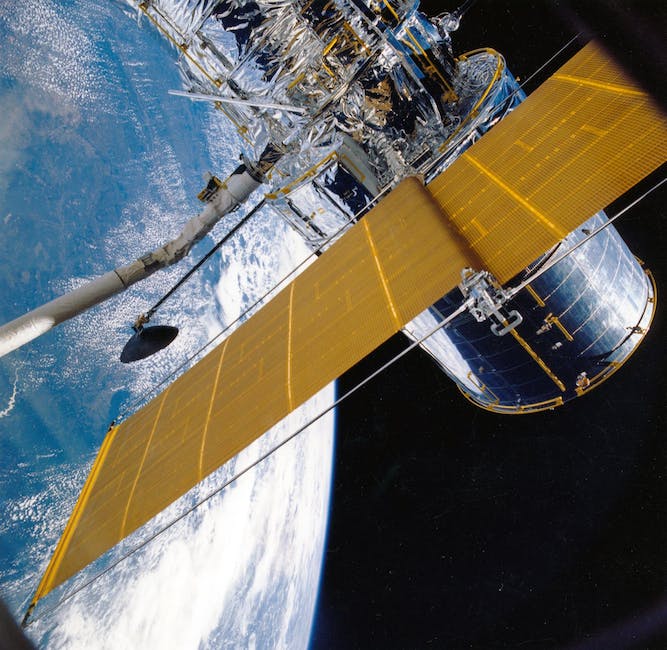Table of Contents
“Arab Leaders in the Aerospace Industry: Soaring High, Breaking Barriers”
Introduction
Introduction:
“Arab Leaders in the Aerospace Industry: Soaring High, Breaking Barriers”
The Arab world has emerged as a significant player in the global aerospace industry, with its leaders making remarkable strides and breaking barriers. Over the years, Arab countries have invested heavily in developing their aerospace capabilities, fostering innovation, and nurturing a skilled workforce. This commitment has propelled Arab leaders to the forefront of the industry, enabling them to contribute to groundbreaking advancements in aviation, space exploration, and defense technology. In this article, we will explore the achievements and contributions of Arab leaders in the aerospace industry, highlighting their remarkable journey of soaring high and breaking barriers.
The Rise of Arab Leaders in the Aerospace Industry

The aerospace industry has long been dominated by Western countries, with giants like the United States and European nations leading the way in technological advancements and market share. However, in recent years, there has been a noticeable rise in Arab leaders in the aerospace industry, as they soar high and break barriers.
One of the key factors contributing to this rise is the increased investment in research and development by Arab countries. Governments in the region have recognized the importance of the aerospace industry in driving economic growth and diversification. As a result, they have allocated significant funds to support research institutions and encourage innovation in the field. This has allowed Arab leaders to develop cutting-edge technologies and compete on a global scale.
Another factor that has contributed to the rise of Arab leaders in the aerospace industry is the growing number of partnerships and collaborations with international companies. Arab countries have recognized the need to leverage the expertise and experience of established aerospace companies to accelerate their own growth. By forming strategic alliances, Arab leaders have been able to access advanced technologies, gain valuable knowledge, and establish a presence in global markets.
Furthermore, Arab leaders in the aerospace industry have been actively promoting education and training programs to develop a skilled workforce. They understand that a strong talent pool is crucial for the industry’s success. Arab countries have established specialized universities and training centers that offer programs in aerospace engineering and related fields. These initiatives have not only provided opportunities for Arab students to pursue careers in the industry but have also attracted international students, further enriching the talent pool.
In addition to investment, partnerships, and education, Arab leaders in the aerospace industry have also been focusing on sustainability and environmental responsibility. They recognize the importance of reducing carbon emissions and minimizing the industry’s impact on the environment. Arab countries have been investing in research and development of eco-friendly technologies, such as electric propulsion systems and lightweight materials. By prioritizing sustainability, Arab leaders are not only contributing to a greener future but also positioning themselves as leaders in the global aerospace industry.
The rise of Arab leaders in the aerospace industry has not been without challenges. They have had to overcome stereotypes and biases that have traditionally associated the industry with Western dominance. However, Arab leaders have proven their capabilities and expertise, challenging these preconceptions and gaining recognition for their achievements.
Looking ahead, the future seems bright for Arab leaders in the aerospace industry. With continued investment, partnerships, and a focus on sustainability, they are well-positioned to further expand their presence and influence. Arab countries have set ambitious goals for the industry, aiming to develop their own satellites, launch vehicles, and even manned missions to space. These aspirations demonstrate the determination and vision of Arab leaders, who are determined to soar high and break barriers in the aerospace industry.
In conclusion, the rise of Arab leaders in the aerospace industry is a testament to their commitment to innovation, collaboration, and sustainability. Through increased investment, partnerships, education, and a focus on environmental responsibility, Arab leaders have been able to compete on a global scale and challenge traditional notions of industry dominance. As they continue to soar high and break barriers, Arab leaders are shaping the future of the aerospace industry and inspiring a new generation of innovators.
Breaking Barriers: Arab Women in the Aerospace Industry
Arab Leaders in the Aerospace Industry: Soaring High, Breaking Barriers
The aerospace industry has long been dominated by men, but in recent years, Arab women have been making significant strides in this field. Breaking barriers and defying stereotypes, these women are proving that gender is no obstacle to success in the aerospace industry.
One of the pioneers in this field is Randa Milliron, the co-founder and CEO of Interorbital Systems. With a background in aerospace engineering, Milliron has been instrumental in developing low-cost launch systems for small satellites. Her innovative approach has revolutionized the industry, making space more accessible and affordable.
Another trailblazer is Hadeel Saadoon, an aerospace engineer from Iraq. Saadoon has been working on the development of unmanned aerial vehicles (UAVs) for military applications. Her expertise in aerodynamics and control systems has contributed to the advancement of UAV technology, enhancing their capabilities and increasing their effectiveness in combat situations.
In addition to these remarkable individuals, there are many other Arab women who are making their mark in the aerospace industry. They are engineers, scientists, and entrepreneurs, all working towards a common goal: pushing the boundaries of what is possible in aerospace technology.
The success of these women is not without its challenges. In a male-dominated industry, they often face discrimination and bias. However, they have persevered, proving their worth through their knowledge, skills, and determination. Their achievements serve as an inspiration to other women who aspire to enter the aerospace industry.
To support and encourage more women to pursue careers in aerospace, various initiatives have been launched. One such initiative is the Arab Women in Aerospace (AWA) program. This program provides mentorship, networking opportunities, and scholarships to Arab women interested in pursuing careers in aerospace. By connecting aspiring professionals with established leaders in the industry, the AWA program aims to create a supportive and inclusive environment for women in aerospace.
The efforts to promote gender diversity in the aerospace industry are not limited to the Arab world. Globally, organizations such as Women in Aerospace (WIA) and the International Astronautical Federation (IAF) are working towards creating a more inclusive industry. These organizations organize conferences, workshops, and networking events to facilitate knowledge sharing and collaboration among women in aerospace.
The impact of Arab women in the aerospace industry extends beyond their individual achievements. Their presence challenges the prevailing stereotypes and biases, paving the way for a more diverse and inclusive industry. By breaking barriers and excelling in their fields, these women are inspiring future generations of Arab women to pursue careers in aerospace.
In conclusion, Arab women are making significant contributions to the aerospace industry, breaking barriers and defying stereotypes. Through their knowledge, skills, and determination, they are pushing the boundaries of what is possible in aerospace technology. Despite facing challenges and discrimination, these women have persevered, proving their worth and inspiring others to follow in their footsteps. With initiatives like the Arab Women in Aerospace program and global organizations promoting gender diversity, the industry is becoming more inclusive and supportive. The achievements of Arab women in the aerospace industry serve as a testament to their talent and determination, and their impact will continue to shape the future of aerospace technology.
Innovations and Achievements of Arab Leaders in Aerospace
The aerospace industry has long been dominated by Western countries, with giants like the United States and European nations leading the way in technological advancements and achievements. However, in recent years, Arab leaders in the aerospace industry have been making significant strides, challenging the status quo and breaking barriers.
One of the most notable achievements of Arab leaders in aerospace is the successful launch of satellites into space. The United Arab Emirates (UAE), for instance, made history in 2018 when it launched its first satellite, KhalifaSat, into orbit. This marked a significant milestone for the UAE, as it became the first Arab country to build and launch a satellite entirely on its own. The success of KhalifaSat was a testament to the UAE’s commitment to developing its space industry and its ability to compete on a global scale.
Another area where Arab leaders in aerospace have excelled is in the development of unmanned aerial vehicles (UAVs), commonly known as drones. Saudi Arabia, for example, has made significant investments in drone technology and has become a major player in the industry. The country’s military has successfully deployed drones for surveillance and reconnaissance purposes, showcasing its technological prowess and ability to innovate in the field of aerospace.
In addition to satellite launches and drone technology, Arab leaders in aerospace have also made significant advancements in the field of aviation. Qatar Airways, for instance, has emerged as one of the leading airlines in the world, known for its luxurious services and state-of-the-art aircraft. The airline has consistently been recognized for its excellence, winning numerous awards and accolades. This success is a testament to the vision and leadership of Arab leaders in the aviation industry, who have worked tirelessly to establish their presence on the global stage.
Furthermore, Arab leaders in aerospace have also been actively involved in research and development, pushing the boundaries of innovation. The King Abdulaziz City for Science and Technology (KACST) in Saudi Arabia, for example, has been at the forefront of scientific research and technological advancements. The institution has collaborated with international partners and has made significant contributions to the field of aerospace, particularly in the areas of satellite technology and space exploration.
The achievements of Arab leaders in the aerospace industry are not only significant in terms of technological advancements but also in terms of breaking barriers and challenging stereotypes. These leaders have shown that Arab countries are not just consumers of aerospace technology but can also be producers and innovators. They have shattered the notion that the aerospace industry is exclusive to Western nations and have proven that Arab countries have the talent, resources, and determination to compete on a global scale.
In conclusion, Arab leaders in the aerospace industry have made remarkable innovations and achievements that have propelled them onto the global stage. From satellite launches to drone technology and advancements in aviation, these leaders have demonstrated their ability to compete with the best in the world. Their accomplishments not only showcase their technological prowess but also challenge stereotypes and break barriers. As Arab leaders continue to soar high in the aerospace industry, the future looks promising, with endless possibilities for further advancements and achievements.
Collaborations and Partnerships: Arab Leaders in the Global Aerospace Industry
The global aerospace industry has witnessed significant growth and development over the years, with Arab leaders playing a crucial role in this progress. Through collaborations and partnerships, these leaders have not only contributed to the advancement of the industry but have also broken barriers and achieved remarkable success.
One of the key factors behind the success of Arab leaders in the aerospace industry is their commitment to forging collaborations and partnerships with global players. By joining forces with established aerospace companies, Arab leaders have been able to leverage their expertise and resources to drive innovation and growth. These collaborations have not only allowed for the transfer of knowledge and technology but have also opened up new avenues for investment and market expansion.
One such example of a successful collaboration is the partnership between the United Arab Emirates (UAE) and Boeing. The UAE has been a key market for Boeing, with the country’s national carrier, Emirates, being one of the largest operators of Boeing aircraft. This partnership has not only resulted in the growth of the UAE’s aviation sector but has also contributed to the development of Boeing’s products and services. Through joint research and development initiatives, the UAE and Boeing have been able to introduce cutting-edge technologies and enhance the efficiency and performance of aircraft.
Another notable collaboration in the Arab aerospace industry is the partnership between Saudi Arabia and Lockheed Martin. Saudi Arabia has been actively investing in its defense capabilities, and this partnership has allowed the country to develop its aerospace industry and strengthen its defense capabilities. Through joint ventures and technology transfer agreements, Saudi Arabia has been able to manufacture and maintain advanced military aircraft, contributing to the country’s self-sufficiency in defense production.
In addition to collaborations with global players, Arab leaders have also been proactive in forming partnerships with other Arab countries. These regional collaborations have not only fostered cooperation and knowledge sharing but have also created a unified front in the global aerospace industry. One such example is the Arab Satellite Communications Organization (Arabsat), which was established by a group of Arab countries to provide satellite communication services. Through this partnership, Arab countries have been able to develop and launch their own satellites, reducing their dependence on foreign providers and enhancing their capabilities in space technology.
Furthermore, Arab leaders have been breaking barriers in the aerospace industry by promoting diversity and inclusion. They have recognized the importance of empowering women and encouraging their participation in the industry. Initiatives such as the Women in Aviation Middle East Chapter have been instrumental in promoting gender equality and providing opportunities for women to excel in the aerospace sector. By breaking down gender barriers, Arab leaders have not only created a more inclusive industry but have also tapped into a vast pool of talent and expertise.
In conclusion, Arab leaders in the aerospace industry have achieved remarkable success through collaborations and partnerships. By joining forces with global players and forming regional alliances, they have been able to drive innovation, enhance capabilities, and expand their market reach. Moreover, by promoting diversity and inclusion, Arab leaders have broken barriers and created a more inclusive industry. As the global aerospace industry continues to evolve, Arab leaders are poised to soar even higher, contributing to the growth and development of the industry on a global scale.
Q&A
1. What is the topic of “Arab Leaders in the Aerospace Industry: Soaring High, Breaking Barriers”?
The topic is Arab leaders in the aerospace industry.
2. What is the main focus of the article?
The main focus is on the achievements and advancements made by Arab leaders in the aerospace industry.
3. What are some key points discussed in the article?
Some key points discussed include the growth of the aerospace industry in Arab countries, the role of Arab leaders in driving innovation and technological advancements, and the barriers they have overcome to succeed in the industry.
4. What is the overall tone of the article?
The overall tone of the article is positive and celebratory, highlighting the accomplishments of Arab leaders in the aerospace industry.
Conclusion
In conclusion, Arab leaders in the aerospace industry have made significant strides in recent years, demonstrating their ability to soar high and break barriers. Through strategic investments, technological advancements, and collaborations with international partners, Arab countries have successfully established themselves as key players in the global aerospace sector. With a focus on innovation, research, and development, Arab leaders are driving the industry forward, contributing to economic growth, job creation, and technological advancements in the region. As they continue to invest in their aerospace capabilities, Arab leaders are poised to achieve even greater heights in the future.





